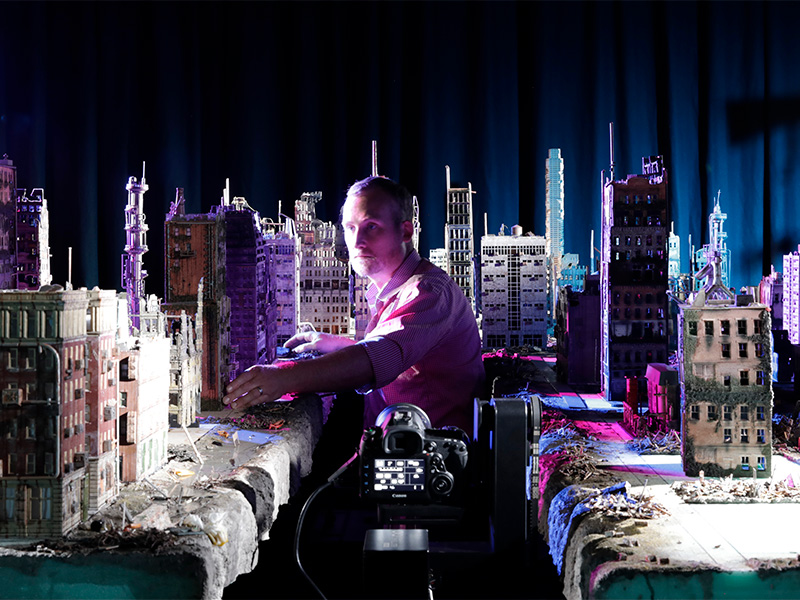Researcher Highlights
From the lecture theatre to the big screen
Jack McGrath
Jack McGrath’s childhood love for stop-motion animation is now helping filmmakers explore new creative frontiers, merging traditional filmmaking techniques with the latest technologies.

Stop-motion is a filmmaking technique that’s been around for well over a century, giving us classic movies such as Wallace and Gromit and Shaun the Sheep. Since its beginnings, the technique has been constantly evolving. University of Newcastle lecturer, Jack McGrath, is on the forefront of this evolution through his work in education, research and as the founder of Sydney-based production company, Conceptavision.
“Stop-motion animation involves taking photographs of a subject, one frame at a time, then stitching them together to create a film,” explains Jack.
“I love how it brings together so many art and design mediums into the one field: from miniature set design, drawing, photography and sculpture to lighting and sound design.”
Jack’s frequent cross-disciplinary collaborations have allowed for traditional and modern techniques to collide in new ways. He works with a range of artisans, from glass artists to sound designers, to push the creative boundaries.
“I’m interested in how new technologies – such as virtual reality and 3D printing – are being merged with traditional techniques. My work is focused on how the physical material processes of animation stay relevant while incorporating these new practices.”
Collisions of old and new
Jack’s collaborative research has resulted in first-of-their-kind films and received global attention. In partnership with glass artist Mark Eliott, Jack produced one of the world’s first glass stop-motion animations. Another recent collaboration sees Jack working with media artist and academic at the University of Sydney, Andrew Robards, and director and academic at the University of Technology Sydney, Matt Gidney, who has worked on big budget feature films such as the Lego Movie and The Clone Wars series. The trio are experimenting with new and emerging technologies such as 3D printing and stereoscopic installations using 3D movie technology.
“For this new work, we are investigating how the materiality and sense of touch inherent in stop-motion animation can be harnessed and perhaps even strengthened by new technologies as we move into the future.”
Together with his international colleagues, the stop-motion practitioner’s work is also raising questions about how we value hand-crafted and physical objects in our increasingly digital world.
“With the rapid escalation of technology away from the physical, tactile, and tangible, what does the experience of the handcrafted, the material and the haptic mean to us? What is the advantage of keeping such art-making practices alive in the twenty-first century for artisans and audiences?”
In his role as university lecturer, and in animation workshops he has run in the past with school students, Jack often sees how stop-motion’s tactile nature provides a unique and valuable learning opportunity.
“Combining the handcrafted with modern-day technologies provides an accessible point for people of all ages and skill levels to get involved in the filmmaking process and communicate with audiences effectively.”
Movies with meaning
Many of Jack’s films aim to raise awareness of current global issues such as health and wellbeing, or environmental protection. He’s helped schools share health messages with their students, helped communities tell their stories, and recently collaborated with a Denmark-based charity for his film Dr Mermaid and the Abovemarine to screen on an “art ship”: raising environmental awareness among young people.
“The art ship sailed from town to town in Denmark and invited young students on board to learn about art and the importance of protecting deep sea life. In addition to being an educational film, Dr Mermaid showcases the value of working with tangible materials.”
For his stop-motion animated film Dr Mermaid and the Abovemarine, Jack and Mark Eliott created a novel way to inform children and adults globally about the dangers of plastic pollution. The duo developed techniques that fused glass flamework with stop-motion animation and digital image capture. The film was screened in galleries in Australia, New York and Denmark.
“By combining modern-day digital and other technologies with the craft and storytelling art of stop-motion animation, my research has allowed for new ways to tell important stories.”
From his small beginnings as a curious 12-year-old experimenting with clay stop-motion animation, to a renowned stop-motion practitioner whose work is watched and loved around the world, Jack continues to push the boundaries of stop-motion. Jack currently has several film projects on the horizon and continues to welcome industry collaborations that allow messages to be told in creative, effective, and meaningful ways.
“There is something very exciting about bringing a film into the world: all of the ideas, frustrations, craft and emotions behind the film consolidate and appear as one, on the screen. The film then has a life of its own.”
The University of Newcastle acknowledges the traditional custodians of the lands within our footprint areas: Awabakal, Darkinjung, Biripai, Worimi, Wonnarua, and Eora Nations. We also pay respect to the wisdom of our Elders past and present.